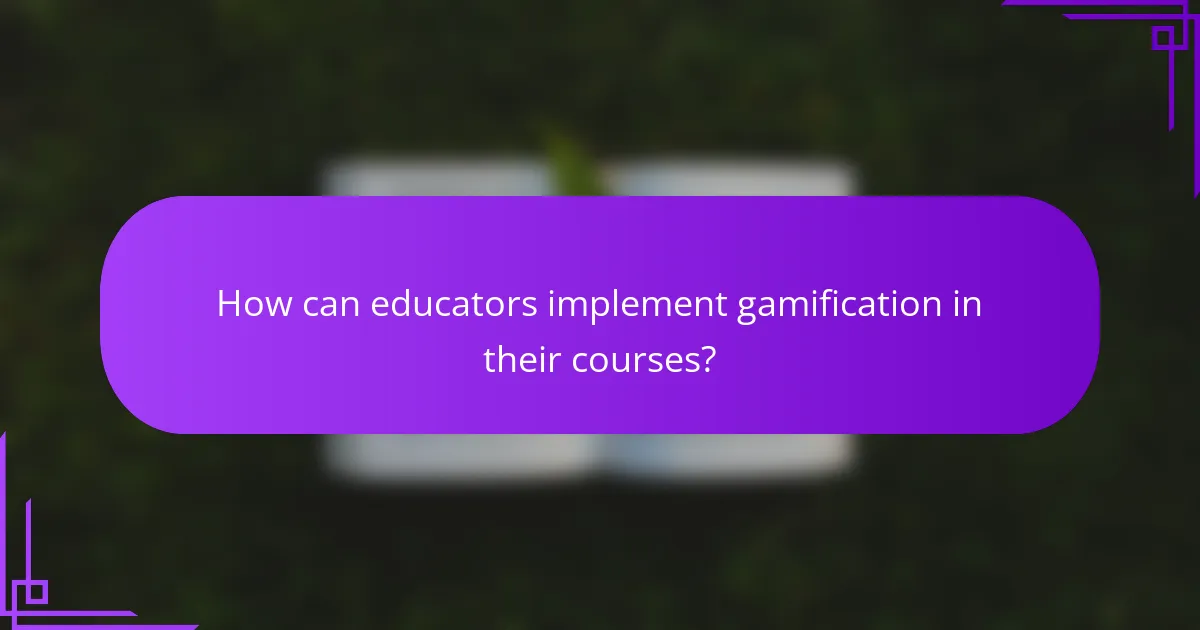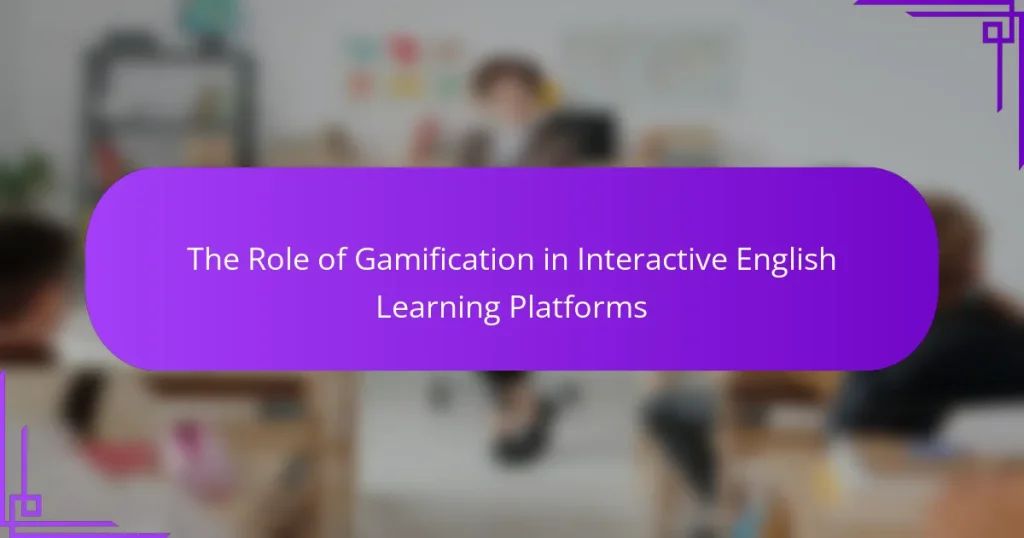Gamification plays a crucial role in interactive English learning platforms by integrating game-like features that enhance engagement and motivation. By utilizing elements such as interactive quizzes, progress tracking, and collaborative multiplayer options, these platforms create an immersive and enjoyable learning experience that encourages learners to advance their language skills effectively.

How does gamification enhance English learning in online platforms?
Gamification enhances English learning in online platforms by incorporating game-like elements that make the learning process more engaging and interactive. This approach not only captures learners’ attention but also motivates them to progress through various language skills in a fun and rewarding way.
Increased engagement through game mechanics
Game mechanics such as points, levels, and badges create a more immersive experience for learners. By integrating these elements, platforms can transform traditional lessons into interactive challenges that encourage users to participate actively. For instance, learners might earn points for completing exercises or unlocking new levels as they master vocabulary.
Additionally, incorporating storylines or quests can further enhance engagement. When learners feel they are part of a narrative, they are more likely to invest time and effort into their studies, leading to better retention of language skills.
Immediate feedback and rewards systems
Immediate feedback is crucial in language learning, and gamification provides instant responses to users’ actions. This allows learners to understand their mistakes and correct them on the spot, which is essential for effective language acquisition. For example, platforms may offer instant corrections on grammar exercises, helping users learn from errors in real-time.
Rewards systems, such as earning virtual currency or unlocking new content, further incentivize learners to engage with the material. These rewards can motivate users to complete more exercises and explore different language aspects, enhancing their overall learning experience.
Enhanced motivation via competition
Competition can significantly boost motivation among learners using gamified platforms. Features like leaderboards allow users to compare their progress with peers, fostering a sense of rivalry that can drive them to improve their skills. This competitive environment encourages learners to practice more frequently to climb the ranks.
However, it is essential to balance competition with collaboration. While some learners thrive in competitive settings, others may feel discouraged. Offering team-based challenges or cooperative tasks can help cater to different learning styles while still promoting motivation through gamification.

What are the key features of gamified English learning platforms?
Gamified English learning platforms incorporate elements of game design to enhance engagement and motivation. Key features include interactive quizzes, progress tracking, and collaborative multiplayer options that create an immersive learning experience.
Interactive quizzes and challenges
Interactive quizzes and challenges are essential components of gamified platforms, providing learners with immediate feedback and a sense of accomplishment. These quizzes often adapt to the user’s skill level, ensuring that they remain challenging yet achievable.
For example, a platform might offer vocabulary quizzes that increase in difficulty as users demonstrate proficiency. This adaptive learning keeps users engaged and encourages them to push their limits.
Progress tracking and achievement badges
Progress tracking allows learners to monitor their advancement over time, which can boost motivation. Many platforms utilize visual dashboards that display completed lessons, scores, and areas needing improvement.
Achievement badges serve as tangible rewards for reaching milestones, such as completing a certain number of lessons or mastering specific skills. These badges can be shared on social media, adding a social element to the learning process.
Collaborative learning through multiplayer options
Collaborative learning features, such as multiplayer options, enable users to interact with peers, fostering a sense of community. This can include group challenges or competitions that encourage teamwork and communication in English.
For instance, platforms may host live quizzes where learners can compete against each other in real-time. Such interactions not only enhance language skills but also build social connections among users.

Which platforms effectively use gamification for English learning?
Several platforms leverage gamification to enhance English learning by making the process engaging and interactive. Notable examples include Duolingo, Kahoot, and Busuu, each employing unique strategies to motivate learners and improve retention.
Duolingo’s game-like structure
Duolingo incorporates a game-like structure that transforms language learning into a fun experience. Users earn points, level up, and unlock new content as they complete lessons, which keeps motivation high.
The platform uses a variety of exercises, including matching words with images and translating sentences, to reinforce learning. Daily goals and streaks encourage consistent practice, making it easier for learners to integrate English study into their routines.
Kahoot’s interactive quizzes
Kahoot utilizes interactive quizzes to create a competitive and engaging environment for English learners. Users can participate in live quizzes or self-paced challenges, allowing for both classroom and individual learning experiences.
The platform’s real-time feedback and leaderboard system foster a sense of competition, motivating learners to improve their scores. Teachers can customize quizzes to target specific vocabulary or grammar points, making it a versatile tool for various learning objectives.
Busuu’s community engagement features
Busuu emphasizes community engagement by connecting learners with native speakers for practice. This social aspect of learning enhances motivation and provides real-world language use opportunities.
Users can submit exercises for feedback from the community, which helps in refining skills and gaining insights into practical language use. Additionally, Busuu offers personalized study plans, allowing learners to focus on areas where they need the most improvement.

What are the benefits of gamification in language acquisition?
Gamification enhances language acquisition by making learning more engaging and interactive. By incorporating game-like elements, learners are motivated to practice more frequently and effectively, leading to better outcomes in vocabulary and grammar retention.
Improved retention of vocabulary and grammar
Gamification helps learners remember vocabulary and grammar rules by creating a fun and competitive environment. For instance, using quizzes and challenges allows learners to reinforce their knowledge through repetition and active engagement. This method can lead to retention rates that are significantly higher than traditional study methods.
Incorporating rewards and levels can further motivate learners to progress, as they see tangible results from their efforts. Simple techniques, like flashcard games or matching exercises, can be effective in enhancing memory retention.
Increased learner autonomy and self-direction
Gamified platforms often allow learners to choose their own paths, fostering a sense of autonomy in their language learning journey. This self-direction encourages learners to set personal goals and engage with content that interests them, which can lead to a deeper commitment to learning.
For example, learners might select specific topics or challenges that resonate with their interests, allowing them to take control of their learning experience. This approach not only boosts motivation but also helps learners develop critical thinking skills as they navigate their choices.
Enhanced social interaction among learners
Gamification often includes social features that promote interaction among learners, such as leaderboards, team challenges, and forums. These elements encourage collaboration and communication, which are essential for language practice. Engaging with peers can provide additional support and motivation, making the learning process more enjoyable.
Participating in group activities or competitions can create a sense of community, where learners feel connected and invested in each other’s success. This social aspect can significantly enhance the overall learning experience, making it more dynamic and effective.

What challenges do educators face with gamified learning?
Educators encounter several challenges when implementing gamified learning, including maintaining educational integrity while engaging students. Balancing the fun elements of games with the necessary educational content is crucial to ensure effective learning outcomes.
Balancing game elements with educational content
Finding the right mix of game mechanics and educational material is essential for successful gamified learning. Too much focus on entertainment can detract from the learning objectives, while overly rigid educational content can make the experience dull. Educators should aim for a harmonious integration, where game elements enhance the learning experience without overshadowing it.
For example, incorporating point systems or badges can motivate students, but these should be tied directly to specific learning milestones. A good rule of thumb is to ensure that at least 70% of the content remains educational, with 30% dedicated to engaging game features.
Addressing diverse learner needs and preferences
Students have varying learning styles and preferences, which can complicate the implementation of gamified platforms. Some learners thrive in competitive environments, while others may prefer collaborative or individual challenges. Educators must consider these differences to create an inclusive experience that caters to all students.
Offering multiple game modes or difficulty levels can help accommodate diverse needs. For instance, providing options for solo play versus team challenges allows students to choose what suits them best, enhancing their engagement and learning effectiveness.
Measuring effectiveness and learning outcomes
Assessing the impact of gamified learning on student performance can be challenging. Traditional assessment methods may not capture the full range of skills developed through gamification, such as teamwork and problem-solving. Educators should implement a mix of formative and summative assessments to gauge both engagement and knowledge retention.
Using analytics tools to track student progress and engagement can provide valuable insights. Regular feedback sessions can also help educators understand how gamified elements are influencing learning outcomes, allowing for timely adjustments to the curriculum as needed.

How can educators implement gamification in their courses?
Educators can implement gamification in their courses by incorporating game-like elements to enhance engagement and motivation. This approach can transform traditional learning into an interactive experience that encourages participation and rewards progress.
Integrating game mechanics into lesson plans
To effectively integrate game mechanics into lesson plans, educators should start by identifying key learning objectives and how game elements can support these goals. Common mechanics include points, badges, leaderboards, and challenges that align with educational outcomes.
For example, teachers can assign points for completing assignments or participating in discussions, and offer badges for achieving specific milestones. This not only motivates students but also provides a clear framework for tracking progress.
Additionally, incorporating collaborative challenges can foster teamwork and communication skills. Educators should ensure that the gamified elements are balanced with educational content to avoid distractions and maintain focus on learning objectives.


